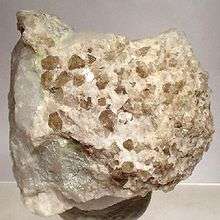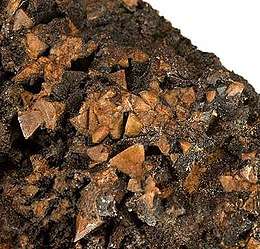Zunyite
| Zunyite | |
|---|---|
|
Sharp, pyramids of brown-red zunyite from Silver City, Tintic District, East Tintic Mountains, Juab County, Utah, US (size: 5.5 x 5 x 3.5 cm) | |
| General | |
| Category | Sorosilicates |
| Formula (repeating unit) | Al13Si5O20(OH,F)18Cl |
| Strunz classification | 9.BJ.55 |
| Crystal system | Isometric |
| Crystal class |
Hextetrahedral (43m) H-M symbol: (43m) |
| Space group | F43m |
| Unit cell | a = 13.8654 - 13.8882 Å; Z = 4 |
| Identification | |
| Color | Grayish white, flesh-red; colorless in thin section |
| Crystal habit | Crystalline - occurs as well-formed fine sized crystals |
| Twinning | On {111}, contact and penetration |
| Cleavage | Good on {111} |
| Fracture | Uneven |
| Tenacity | Brittle |
| Mohs scale hardness | 7 |
| Luster | Vitreous |
| Streak | White |
| Diaphaneity | Transparent to translucent with inclusions |
| Specific gravity | 2.874(5) (meas.) 2.87 - 2.90 (calc.) |
| Optical properties | Isotropic |
| Refractive index | n = 1.592 - 1.600 |
| Other characteristics | May fluoresce red under UV |
| References | [1][2][3] |
Zunyite is a sorosilicate mineral, Al13Si5O20(OH,F)18Cl, composed of aluminium, silicon, hydrogen, chlorine, oxygen, and fluorine.
Occurrence

Glassy, translucent, gray-tan, pseudohexagonal zunyite crystals on a milky quartz matrix. From the Big Bertha Mine, Dome Rock Mountains, La Paz County, Arizona (size: 3.3 x 3.2 x 2.8 cm))
Zunyite occurs in highly aluminous shales and hydrothermally altered volcanic rocks. It occurs in association with pyrophyllite, kaolinite, alunite, diaspore, rutile, pyrite, hematite and quartz.[1]
It was discovered in 1884, and named for its discovery site, the Zuni mine in the Silverton District, San Juan County, Colorado.[2]
References
- Glendale Community College; retrieved March 26, 2005.
- Euromin; retrieved March 26, 2005.
| Wikimedia Commons has media related to Zunyite. |
This article is issued from
Wikipedia.
The text is licensed under Creative Commons - Attribution - Sharealike.
Additional terms may apply for the media files.
